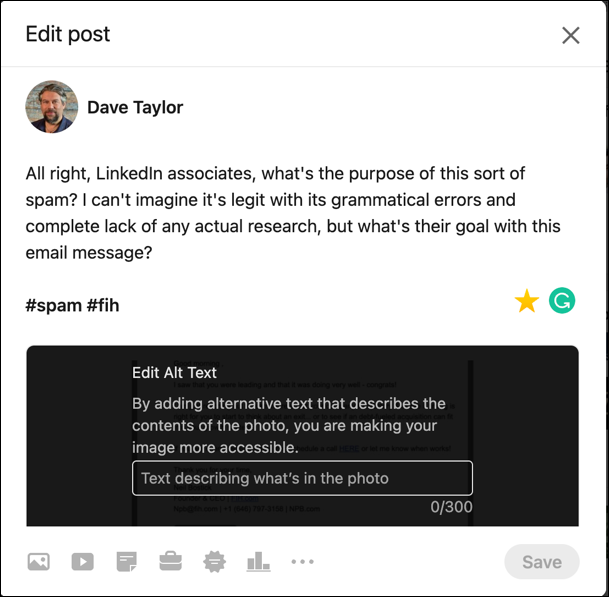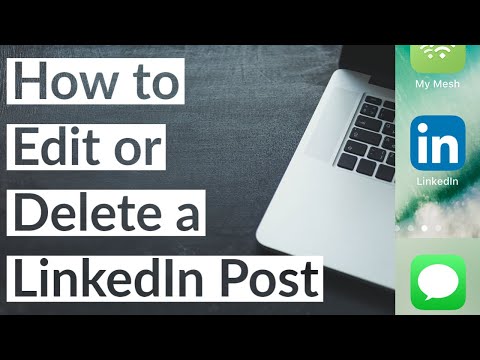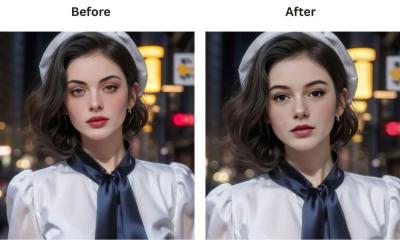Ever found yourself in a situation where a valuable LinkedIn post went missing? Whether it was a thoughtful article, an insightful comment, or a significant update, the frustration can be real. In this blog post, we’ll dive into the nitty-gritty of LinkedIn post deletion. Can you really see deleted posts? Let’s uncover the facts and explore the options available to you!
Understanding LinkedIn Post Deletion

When you hit that delete button on a LinkedIn post, it’s easy to think it’s gone for good. But what does that really mean? Understanding the mechanics behind deletion is essential. Here’s a quick rundown:
- Permanent or Temporary? – Deleted posts are generally removed from your public profile and the LinkedIn feed, making them invisible to others. However, they can still exist in LinkedIn's internal systems for a while.
- User Actions – You can delete your own posts, but if someone else has shared or interacted with your post, it remains visible on their feed until they choose to remove it.
- Archive vs. Delete – LinkedIn does not offer an official archiving feature, so once a post is deleted, it doesn’t get archived in a recoverable format.
Now, here’s the kicker: while the platform doesn’t provide any built-in tools for recovering deleted posts, some users have reported success in finding them through email notifications or saved links. Still, it’s not reliable.
So, next time you consider deleting a post, think twice! If it’s a matter of a small edit or a change in visibility, there might be alternatives to deletion, like adjusting privacy settings or editing the content instead.
Also Read This: How to See Deleted LinkedIn Posts: Can It Be Done?
3. Methods to Recover Deleted Posts

Ever found yourself regretting a post you deleted on LinkedIn? Don’t worry, you're not alone! While retrieving deleted posts is not straightforward, there are a few methods you can try. Here’s a breakdown:
- Check Your Email Notifications: When you post on LinkedIn, you often receive email notifications. Search through your inbox for emails related to your post. These emails might contain excerpts or links that can help you recall the content.
- Contact LinkedIn Support: If it's a significant post, reaching out to LinkedIn support might be worth a shot. Explain your situation and provide details. While they don’t guarantee recovery, they might offer guidance.
- Explore Third-Party Tools: Some services claim they can help retrieve deleted social media content. However, use these with caution and do thorough research to avoid compromising your data.
- Check Your Browser History: If you accessed the post recently, your browser history might have the page saved. Look for LinkedIn URLs that could lead you back to the post.
While these methods may not ensure a foolproof recovery, they provide a starting point for those precious insights that slipped away.
Also Read This: How to Add a Video to Your LinkedIn Post to Boost Engagement
4. Using LinkedIn’s Archive Feature
Did you know LinkedIn has an Archive feature? This nifty tool can be a lifesaver if you want to revisit your past posts without the risk of deletion. Here’s how to use it:
- Access Your Archive: Navigate to your LinkedIn profile and look for the “Me” option at the top. Click on “Posts & Activity,” and you’ll spot the archived content.
- Filter Your Posts: Use filters to narrow down your search. You can sort by date, type of content, or even engagement levels. This makes finding specific posts much easier!
- Review Archived Content: Clicking on an archived post will bring it back for viewing. You can copy the text, re-edit, or even share it again if you choose.
Using this feature not only helps you keep track of your content but also ensures you don't lose valuable insights. So, make it a habit to archive your important posts before hitting that delete button!
Also Read This: How to Find an Email Address on LinkedIn: Strategies for Contacting
Third-Party Tools and Their Effectiveness
When it comes to retrieving deleted LinkedIn posts, third-party tools can be a mixed bag. While there are several options out there, it’s essential to approach them with caution. Some tools claim to restore deleted content or provide backups, but their effectiveness can vary significantly.
Here are a few points to consider:
- Data Recovery Software: Some users have turned to data recovery software that scans hard drives for lost files. While this may work for personal documents, it typically won’t help with deleted posts on LinkedIn.
- Browser Extensions: Certain browser extensions claim to save your posts automatically. If you've installed one before deleting your post, you might find your content stored there.
- Social Media Management Tools: Tools like Hootsuite or Buffer may have features that allow you to schedule and track your LinkedIn posts. If you used these tools, there's a chance you can retrieve your post history.
However, always be wary of sharing your LinkedIn credentials with third-party tools. It’s crucial to use reputable services to avoid compromising your account security. In the end, while these tools can help, there’s no guarantee they will recover deleted posts.
Also Read This: How to Extract LinkedIn Contacts for Better Lead Management
Best Practices for Future Posts
With the risk of losing valuable content in mind, implementing best practices for your LinkedIn posts can help you maintain a robust online presence. Here are some tips to consider:
- Draft Before Posting: Use a word processor to draft your posts. This way, you have a saved copy that you can always refer back to, even if you accidentally delete it from LinkedIn.
- Use LinkedIn’s Draft Feature: LinkedIn allows you to save drafts of your posts. Take advantage of this feature to ensure you don't lose your content prematurely.
- Regular Backups: Consider taking periodic screenshots of your posts or using tools that provide a backup of your social media content.
- Engage with Comments: Keep an eye on the comments section of your posts. Engaging with your audience not only boosts visibility but also reinforces the value of your content.
By following these best practices, you can mitigate the chances of losing important posts and ensure that your LinkedIn profile remains a valuable resource for your professional network.
How to See Deleted LinkedIn Posts: Can It Be Done?
LinkedIn is a powerful platform for professionals to connect, share insights, and showcase their work. However, there may come a time when you accidentally delete a post that you wish to view again. This raises a common question: can deleted LinkedIn posts be recovered or viewed? Let's explore the possibilities.
When a post is deleted on LinkedIn, it is removed from the public view, but there are a few avenues you might explore to see if you can retrieve that content:
- Check Your Activity Log: LinkedIn provides an activity feed where you can see your past interactions. Navigate to your profile, click on the 'Activity' section, and browse through your previous posts.
- Use Cached Pages: If your post was public, there might be a cached version available on search engines. Search for your post content on Google and check if a cached version exists.
- Contact LinkedIn Support: If the post was crucial, reaching out to LinkedIn's customer service might yield results. They may help in recovering your content if possible.
- Third-party Tools: Some social media management tools may allow you to schedule posts and keep records. If you used any, check their archives.
It's important to note that once a post is deleted, it is generally considered permanent. LinkedIn does not provide a built-in feature for recovering deleted posts, which emphasizes the importance of being careful before hitting the delete button.
Conclusion: While recovering deleted LinkedIn posts is challenging, exploring your activity log, checking cached pages, and possibly contacting LinkedIn support are your best options. Always remember to keep backups of important content to avoid similar situations in the future!
 admin
admin








